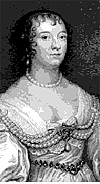 During the very earliest days of the English Civil War, a young nobleman, Lord Strange made the decision, King or Parliament, with rapidity.
During the very earliest days of the English Civil War, a young nobleman, Lord Strange made the decision, King or Parliament, with rapidity.
James Stanley, 7th Earl of Derby
James Stanley, Lord Strange and later Earl of Derby, held lands in the North West of England and held sovereign rights to the Isle of Man. His power and influence over his lands and the area around them was immense and fearsome, being still semi-feudal. Derby’s principal family seat was Lathom House, near Manchester.
The house was much larger than its name suggests and dated from around the early 16th century.
Derby’s wife had just as much ancestry and influence as himself, being loaded with famous relatives. She was granddaughter of William the Silent who was ruler of Holland, Cousin of the King’s Nephew Prince Rupert, daughter of a French Duke and with Bourbon blood in her from her mother.
Derby quickly threw his hat into the ring in mid 1642, by proclaiming the King’s call to arms in Preston.
This event and his march to try and capture Manchester’s magazine of arms, soon proved that most of the people in his lands were fervently against the cause he embraced.
He was driven out of Manchester after panic ensued at his arrival and skirmishing led to firing and deaths, possibly the first major skirmish of the war.
As war fully arrived, Derby was appointed to the independent command of the Royalists in the North West. He looked to the local implications of the war very closely, focusing on his own lands. He viewed that the rebellion was not only against the King, but also in Lancashire, it was against himself too and he became very strong-willed in combating the fact that most of the people of Manchester and surrounding, were strongly Puritan and hostile.
As such, he acted with resolute and swift action whenever he could, vehemently displaying his loyalty. It was not long before the chariot of war blazed into Lancashire and Lathom itself came under siege.
 In May 1643, while Lord Derby was away campaigning, the resolute Countess was summoned to surrender Lathom.
In May 1643, while Lord Derby was away campaigning, the resolute Countess was summoned to surrender Lathom.
Charlotte, Countess of Derby
Situated in a marshy hollow, with layers upon layers of turreted walls around it, the principal defence was that it stood majestically on wooded hilly ground, with a moat hugging its circumference.
Although she was left virtually unmolested, the Countess was virtually a prisoner in her own home. She had agreed to hand over all revenues of their estates, but managed through this to gain time to prepare for the inevitable.
Garrison
She built up her garrison like an experienced commander to three hundred, carefully making sure her men never committed any acts of terror, which could provoke her enemy at this early stage.
In February 1644 after Lady Derby had gathered in supplies, the sleeping enemy awoke. She was suddenly denounced from the Church pulpits as the Scarlet Whore of Babylon, showing how the enemy lied and cheated, veiling their attacks under religion and making reference to the Catholicism of Lathom’s inhabitants. Lady Derby was in fact a committed Calvinist.
Lathom was surrounded by now with two to three thousand Roundheads, but before any attack, Sir Thomas Fairfax sent terms for her perusal, inviting her out for talks.
Fairfax must have been astonished with the resolution which leaked and then gushed from the house, for the Countess replied it was, “More knightly that Sir Thomas should wait upon her, than she upon him,” reminding him of her high birth.
As Fairfax arrived at the house for talks, he found that the Countess had lined her soldiers up on either side of the courtyard, providing Fairfax with a stony and cold welcome.
As he walked from the entrance through the men, which stretched to the Great hall, seeing the towers and walls crammed with others, Fairfax must have had his eyes opened as to what he was up against.
Nothing was achieved diplomacy wise, but the able Countess had set the scene for the beginning of hostilities, her organised reception for Fairfax giving her the edge.
Fairfax left the siege in the hands of Colonel Alexander Rigby, telling him he could not do something so, “Ignoble and unmanly,” as storming a lady in her own house; he must besiege it until she were forced to surrender.
Ever observant and quick, the Countess had slipped in another trump card to her hand when her chaplain had told one of Fairfax’s party, that they could only hold out for two weeks.
This rumour soon spread through the enemy and it was not until Rigby summoned her to surrender two weeks later and found her as determined as ever, that he realised his grave error.
On 12th March, the rebels under Rigby made the first shot against her. The Countess was more than ready to counteract.
She had appointed her officers, pushed the gamekeepers and fowlers to the top of the towers, being the best marksmen and the following day took the initiative by sallying out and flawing Rigby’s underestimation of her.
All Rigby could do for the three weeks it took him to construct earthworks, was to continually receive embarrassment.
On the first sally, the Lathom men took some prisoners, killing thirty men, following this up with other sallies.
Mortar
Then for the first time, the Countess perceived some irritation and inconvenience, when Rigby hauled up a huge mortar piece from London. Very soon, this piece was in action, firing grenades down on the house.
The Countess seemed perpetually hassled by unexpected guests; a mortar crashed though her bedroom window, another exploded close to where she was having dinner with her daughters and she had to organise a fire party to be on standby for any hour of the day or night. The Countess however kept up her faith and led the garrison’s moral, supporting it through the tough times.
At the end of April, Rigby resolved to use fireballs and as such, sent a note to the Countess, warning her and demanding surrender. As the messenger brought it to her, she stood in the presence of her soldiers and took the note.
When her pale plump face looked down at the note, her eyes changed and she ripped it up rather ceremoniously, speaking in a loud voice to all present, “Tell that insolent rebel that he shall neither have persons, goods, nor house; when our strength and provision is spent, we shall find a fire more merciful than Rigby and then if the providence of God prevent it not, my goods and house shall burn in his sight; myself, children and soldiers included…we shall seal our loyalty within the same flame.”
The soldiers burst into praise, shouting no less passionately, “We’ll die for His Majesty and your honour. God save the King!”
Riding high on this wave of fervour and loyalty, the Countess and her men began to hatch a stunning plot.
At dawn the following day, the Countess’s men rushed out of the gates, still infected with their resolution from the previous day, and made toward the earthworks.
As they drove the enemy away like sheep, a party of her servants levelled the ditch where the mortar stood and with the Countess cheering them on from outside the gates, heaved the mortar onto a trolley.
In a spectacular fashion, they dragged the mortar back into its former target, terminating the endless recent bombing.
They swarmed about it with glee, lapping up the feeling of seeing the offensive piece lying in front of them, like a dead lion and proudly recounting their success.
Rigby stood outside, deflated and at his ends. The only road now was to starve them out, but he knew fine well that the sands of time were quickly slipping out of his grasping and desperate hands.
Prince Rupert was on his way with a Royalist army, containing her proud husband, Lord Derby. Anxious for his wife’s safety and desirous to hold her again after her success, Derby distributed £3000 amongst the men, to encourage them to march faster.
On 27th May 1644, Rigby and his men committed the finale in his tragic attempt at siege warfare and fled. After three months of siege, he had lost honour, men, a mortar and morale. The Countess stood in Lathom with all of the former and was presented with something else to complement her achievements.
Prince Rupert stormed Bolton and defeated Rigby and his men, presenting the colours of their army to the Countess to hang in her great hall.
As Charlotte Stanley stood with her standards in the hall, she doubtless knew she had secured a place in history, for her brave and ingenious defence of her King’s cause, husbands honour and protection of her house. In total, she had lost only six men.
Bibliography
Bence-Jones, Mark, The Cavaliers 1977
Hibbert, Chrisptoher, Cavaliers and Roundheads 1995
Fraser, Antonia, The Weaker Vessel 1999
Useful Websites and Sources
www.kingorparliament.com -- My own website containing history and information about the 17th century
http://www.isle-of-man.com/manxnotebook/people/lords/lathom.htm -- Website about Lathom and the Derby’s
Back to Table of Contents -- King or Parliament #2
Back to King or Parliament List of Issues
Back to MagWeb Magazine List
© Copyright 2002 by Mark Turnbull.
This article appears in MagWeb (Magazine Web) on the Internet World Wide Web.
Other military history articles and gaming articles are available at http://www.magweb.com